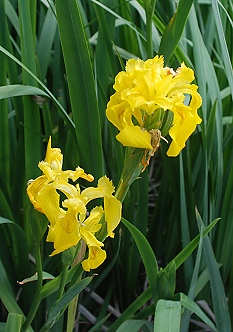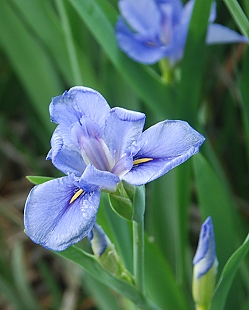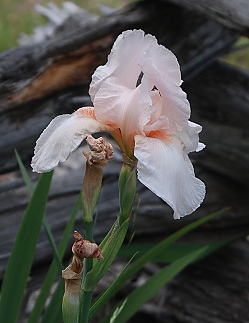Despite the way their roots attack the pumps, we plant water iris in the larger permanent water features: they offer desirable habitat for odonates above water, and shelter for tadpoles, red-lined ribbon snakes, and other aquatic critters below the water surface. And though the “land” iris isn’t native here, I enjoy the older varieties that still mark out house-sites and yards in fields where a homesteader’s house has long vanished.

This robust yellow water iris multiples quickly and once more we need to yank about half of it out of the big pond–but it’s attracted hummingbirds and butterflies as well as the odes that perch on it and (some of them) use the stems to lay their eggs in.
Less robust–it’s easily outcompeted by the taller, faster-multiplying yellow–is this lovely blue water iris, native to East Texas and Louisiana.

In a wet year, we planted both varieties (taken while reducing the numbers in the yard water feature) down in the creek woods, in one of the overflow channels. They have survived, but die back in dry years–and the blues, my favorite, may not survive this drought down there. When they bloom next to the “swamp overflow” they are stunning.
I like most irises, and am grateful for gifts of starts from local residents, but if I have a favorite it’s this soft, delicate peach. We have planted iris in the angles of the “snake fence” made from old fence posts.

The “land” irises we have survive with little or no watering and I love the “homestead” look of the rail fence and the iris in its niches. Also growing on the fence now is a Virginia creeper, and one of the very old rambling roses (dark, dark red, small flowers) is now crawling up the far side.
In our climate, irises are invasive only in water gardens, so it’s safe to plant even the non-native ones in a mostly-native landscape, or leave them in place if you find them. Only the hardy will survive without extra water. The commonest “old homesite” varieties are a pure white (smaller than most modern ones) and a rich yellow (same yellow as the water iris.) There’s also a hardy small purple and small blue-lavender. In an intermittent pond/slow stream, the water irises (which are native in many places) may survive and will propagate only slowly; in permanent water of the right depth they will spread with amazing speed, like cattails.
Comment by cdozo — April 16, 2009 @ 7:51 am
My mom planted daffodils, narcissus and crocuses at my house in Connecticut. So when I bought the land, I planted some daffodils and narcissus. The came up for a few years, but this year I didn’t see any of them. I guess the drought may have taken its toll.
But your beautiful iris photos have inspired me to go native. I’ll put some irises out there at the beginning of next fall. There used to be some here at my rent house, but they stopped blooming. I’ll try and remember to dig some up before I move out.
Comment by elizabeth — April 16, 2009 @ 7:57 am
There’s a hardy narcissus (I think it is) that will survive down here. I have some. The next time you visit, let’s divide a bunch. Crocuses and tulips are a lost cause, and so are 95% of the daffs. Iris…we have a *ton* (quite literally, the darn things are heavy) of the yellow water iris, which would be lovely down on your shoreline. The land irises can be transplanted right after they bloom, if you can give them some water the first summer. Mine came from a lady in town who was divvying up hers to open bed space.
Comment by gunhilda — April 16, 2009 @ 9:45 am
Beautiful irises! My land varieties are just starting to bloom (purple, yellow, white, and a rust/maroon color that is very lovely). I planted a water iris in the water garden last year and it spread nicely, but no flowers this year. 🙁
Comment by elizabeth — April 16, 2009 @ 11:32 pm
I’m trying to remember if our water iris flowered the first year or not…I’m not sure, but I’ll bet yours will in time.
Comment by Chuck — April 17, 2009 @ 9:13 pm
I’m reminded that Tolkien’s “Gladden Fields,” where Isildur was betrayed by the Ring and slain, was a marsh named for the “armies of yellow iris that grew taller than a man …[that] gave their name to all the region and to the river … about whose lower course they grew most thickly.” (Unfinished Tales.) “Glaeddon” is the Anglo-Saxon name for the iris, I believe.
When my grandmother married and moved to north Mississippi, her mother-in-law gave her some “jonquil” bulbs — larger blooms than what she called “April white narcissus,” smaller than daffodils. Eventually those came to Texas to live at my mother’s house, both the one I live in now and the one my parents built out in the country. Here in Tarrant and Parker counties, they tend to bloom in late February to early March. I’ve noticed similar narcissi around old houses or places where the houses are gone, but the flowers keep coming back each year.
Comment by elizabeth — April 17, 2009 @ 11:39 pm
The yellow water iris certainly gets as tall as I am!
I love the old homestead flowers. On a field trip to Fort Hood last year, our guide pointed out a place where a ranch house had been until Fort Hood expanded during WWII. In the middle of a bare, rocky area, at the base of a hill, there was a small mound of stones from the old fireplace, and about where the front of hte house would have been (guessing) a huge, lush *lilac*! Now that is tough! Central Texas is not lilac country, and that lilac hadn’t had any care or extra watering for well over fifty years…and there it was.